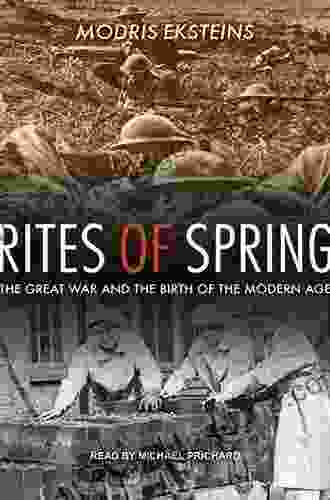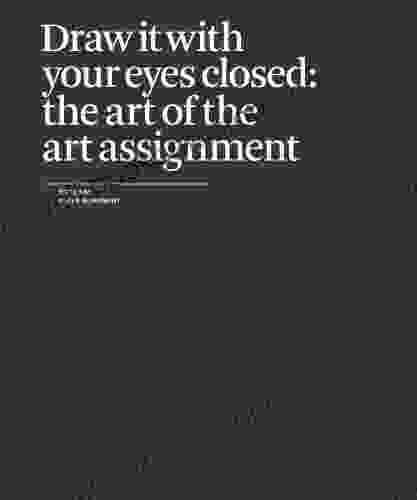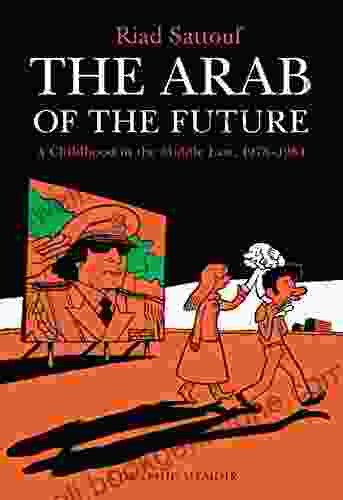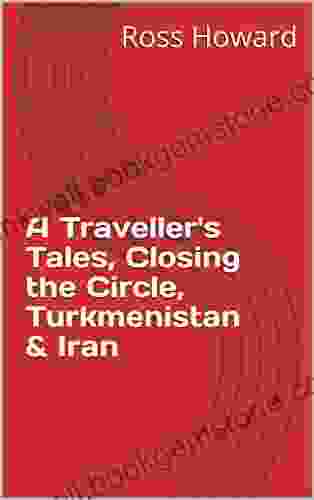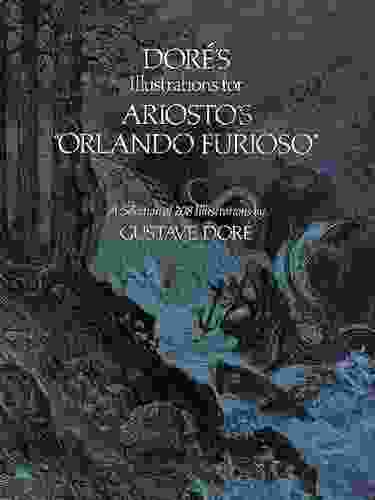The Great War: A Catalyst for the Birth of the Modern Age

The Great War, also known as World War I, erupted in Europe in August 1914, marking a profound turning point in human history. The conflict had been brewing for decades due to a complex interplay of political, economic, and territorial tensions.
Nationalism and imperialism were on the rise, with competing European powers seeking to expand their empires and assert their dominance. Alliances were formed between nations, creating a web of interdependent relationships that would ultimately lead to a massive escalation of hostilities.
The assassination of Archduke Franz Ferdinand of Austria by a Serbian nationalist on June 28, 1914, acted as a trigger for the outbreak of war. Within weeks, the major European powers were mobilized, and the conflict quickly spread across the globe.
4.5 out of 5
| Language | : | English |
| File size | : | 2279 KB |
| Text-to-Speech | : | Enabled |
| Screen Reader | : | Supported |
| Enhanced typesetting | : | Enabled |
| Word Wise | : | Enabled |
| Print length | : | 418 pages |
| Lending | : | Enabled |
At the outset, many believed the war would be a short and decisive affair. However, it soon became clear that this was not to be the case. The fighting was far more brutal and prolonged than anyone had anticipated, dragging on for four bloody years.
The Great War witnessed a number of significant technological innovations that had a profound impact on the course of the conflict. These included:
Machine guns: Highly effective at suppressing enemy fire and inflicting heavy casualties, machine guns became a ubiquitous feature of trench warfare.
Artillery: Heavy artillery pieces were used to shell enemy positions from a distance, causing widespread destruction and loss of life.
Poison gas: Chemical weapons, such as chlorine and mustard gas, were introduced for the first time, leading to horrific casualties and suffering.
Airplanes and zeppelins: Aerial warfare played an increasingly important role, with both sides using planes for reconnaissance, bombing, and dogfights.
The industrialization of warfare transformed the conflict into a vast and impersonal killing machine. Mass mobilization resulted in millions of men being conscripted into the armed forces, while factories and industries were converted to produce munitions and supplies.
The Great War was one of the deadliest conflicts in human history. By the time the fighting ended in November 1918, approximately 40 million people had been killed, wounded, or missing.
Entire generations of young men were wiped out, leaving a lasting impact on the demographics and social fabric of Europe. The war also had a devastating effect on civilians, with many dying from disease, starvation, or the indirect effects of violence.
The Great War had a profound impact on the political and social landscape of Europe and the world. The old order of monarchies and empires crumbled, replaced by new nation-states and political ideologies.
The rise of communism: The Russian Revolution of 1917, sparked in part by the hardships of the war, led to the establishment of the first communist state.
The League of Nations: In an attempt to prevent future conflicts, the League of Nations was established in 1920 as an international organization to promote cooperation and resolve disputes.
Women's suffrage: The war effort required the mobilization of women into the workforce, leading to increased calls for political equality and the right to vote.
The Great War also marked a significant turning point in cultural and intellectual thought. The horrors of trench warfare and the massive loss of life led to a widespread loss of faith in traditional values and institutions.
Modernism: The war inspired a new artistic and literary movement known as modernism, which rejected traditional forms and embraced experimentation and fragmentation.
Lost Generation: The term "Lost Generation" was coined to describe the generation of writers and artists who came of age during the war and were deeply affected by its experiences.
Existentialism: The war raised fundamental questions about human existence and meaning, leading to the development of existentialist philosophy, which emphasized individual freedom and responsibility.
The Great War left an enduring legacy on the world. It marked the end of an era and the beginning of a new one, characterized by increased technological advancements, social and political upheaval, and cultural and intellectual shifts.
The war also had a lasting impact on international relations, setting the stage for the outbreak of World War II and the Cold War. The lessons learned from the Great War continue to shape global diplomacy and efforts to prevent future conflicts.
The Great War was a pivotal event in human history, marking the end of an era of relative stability and the beginning of a period of rapid transformation. It was a conflict that reshaped the political, social, and cultural landscapes of the world, leaving an enduring legacy that continues to resonate today.
Alt attribute for image 1: A black-and-white photograph of soldiers marching through a trench during World War I.
Alt attribute for image 2: A color photograph of a group of wounded soldiers receiving medical treatment in a field hospital during World War I.
Alt attribute for image 3: A color photograph of a group of people protesting against the war in London, England, during World War I.
Alt attribute for image 4: A black-and-white photograph of a group of artists and writers gathered at a cafe in Paris, France, during the interwar period.
4.5 out of 5
| Language | : | English |
| File size | : | 2279 KB |
| Text-to-Speech | : | Enabled |
| Screen Reader | : | Supported |
| Enhanced typesetting | : | Enabled |
| Word Wise | : | Enabled |
| Print length | : | 418 pages |
| Lending | : | Enabled |
Do you want to contribute by writing guest posts on this blog?
Please contact us and send us a resume of previous articles that you have written.
 Best Book
Best Book Page Flip
Page Flip Bookshelf
Bookshelf Literary loom
Literary loom Chapter
Chapter Bookish
Bookish PageTurner
PageTurner Bibliophile
Bibliophile Story
Story Inkwell
Inkwell Bookworm
Bookworm Labyrinth
Labyrinth Plot Twist
Plot Twist Prose
Prose Paperback
Paperback Storyteller
Storyteller Sanctuary
Sanctuary Fiction
Fiction Reading
Reading Chronicle
Chronicle Read
Read Orson Scott Card
Orson Scott Card Jesse Storm
Jesse Storm Emily Craft By Maker Academy
Emily Craft By Maker Academy Nicholas Wapshott
Nicholas Wapshott Michael R Fletcher
Michael R Fletcher Doris Lessing
Doris Lessing Edward Brody
Edward Brody Dick Durham
Dick Durham Helen Keller
Helen Keller Brian Dougherty
Brian Dougherty Daniel Gross
Daniel Gross Derek Murphy
Derek Murphy Megan Hess
Megan Hess Kate Betts
Kate Betts Joey Korenman
Joey Korenman William Dalrymple
William Dalrymple Dianne Pineda Kim
Dianne Pineda Kim Graham Webb
Graham Webb Emiliano Zapata
Emiliano Zapata Nichole Perkins
Nichole Perkins Edmund S Wong
Edmund S Wong James A Moore
James A Moore Janet Wood
Janet Wood Uncle Brazil
Uncle Brazil Devin Harbison
Devin Harbison Don Peri
Don Peri Langston Hughes
Langston Hughes Lexie Winston
Lexie Winston Geniuz Gamer
Geniuz Gamer Maria Hinojosa
Maria Hinojosa Rachel Mclean
Rachel Mclean Vasily Mahanenko
Vasily Mahanenko George Catlin
George Catlin James Goddard
James Goddard C M Carney
C M Carney Peter Spiegelman
Peter Spiegelman Stephen Clarke
Stephen Clarke Nathan Hystad
Nathan Hystad John Brunner
John Brunner Jackie Barrass
Jackie Barrass Susanna Kaysen
Susanna Kaysen Wilfrid Jonson
Wilfrid Jonson E E Knight
E E Knight Phyllis Klotz
Phyllis Klotz Kassanna
Kassanna Joe Holt
Joe Holt Diane Keaton
Diane Keaton Desmond King
Desmond King Tilar J Mazzeo
Tilar J Mazzeo Scott Kloos
Scott Kloos William Silvers
William Silvers Jane Maday
Jane Maday Lisa Kleypas
Lisa Kleypas Jacques Derrida
Jacques Derrida Rohan M Vider
Rohan M Vider Kellye Garrett
Kellye Garrett Emily Colson
Emily Colson Richard Huber
Richard Huber Kareem Aal
Kareem Aal Victoria Lewis
Victoria Lewis Luke Zimmermann
Luke Zimmermann Jeff Lenburg
Jeff Lenburg Emily Carr
Emily Carr Robert E Howard
Robert E Howard Ashleynicole
Ashleynicole Jean Pierre Isbouts
Jean Pierre Isbouts Karen Campbell
Karen Campbell Emily Scherb
Emily Scherb Eliza Ruhamah Scidmore
Eliza Ruhamah Scidmore Glenn Rudin
Glenn Rudin Hadley Freeman
Hadley Freeman Izzy Paskowitz
Izzy Paskowitz Douglas Johnson
Douglas Johnson Paul Noble
Paul Noble Michael Arndt
Michael Arndt Scott Eyman
Scott Eyman Jesse Mccarthy
Jesse Mccarthy Neil Bennion
Neil Bennion Neil Baldwin
Neil Baldwin J R Ward
J R Ward W R Tymms
W R Tymms Sylvia Foster
Sylvia Foster Nicholas Gill
Nicholas Gill Rachel Polonsky
Rachel Polonsky Ralph Cotton
Ralph Cotton James R Lilley
James R Lilley Emma Gift
Emma Gift Joy Deja King
Joy Deja King Elin Hilderbrand
Elin Hilderbrand Lucy Coleman
Lucy Coleman Dominick Dunne
Dominick Dunne Doug Gelbert
Doug Gelbert Pam Young
Pam Young Douglas Segal
Douglas Segal E M Forster
E M Forster Emil Draitser
Emil Draitser S J Pajonas
S J Pajonas John Dickie
John Dickie Jonathan Yanez
Jonathan Yanez Lady Dia
Lady Dia Ebony Roberts
Ebony Roberts Liza Rodman
Liza Rodman Kate Lock
Kate Lock John F Harnish
John F Harnish Geoff Kersey
Geoff Kersey Luana Luconi Winner
Luana Luconi Winner Ellen Eagle
Ellen Eagle Madeleine Orban Szontagh
Madeleine Orban Szontagh Yuri Leving
Yuri Leving Tina Fey
Tina Fey Dom Joly
Dom Joly Luigi Amara
Luigi Amara Louis Blanc
Louis Blanc Ellen Murkison
Ellen Murkison Ruth Wilshaw
Ruth Wilshaw Regis Yaworski
Regis Yaworski Zongyan Hu
Zongyan Hu E John B Allen
E John B Allen Eddie Armer
Eddie Armer Jack Campbell
Jack Campbell Taylor Dibbert
Taylor Dibbert Jade Royal
Jade Royal Patrick Youngblood
Patrick Youngblood James Egan
James Egan Duncan Barrett
Duncan Barrett Donna Everhart
Donna Everhart Karen Kluglein
Karen Kluglein Debra Kayn
Debra Kayn Michael R Pitts
Michael R Pitts Tjio Kayloe
Tjio Kayloe Linda Riesenberg Fisler
Linda Riesenberg Fisler Duncan M Webb
Duncan M Webb E E Smith
E E Smith William Blake
William Blake Jeanne St James
Jeanne St James Rosemary Mahoney
Rosemary Mahoney Elizabeth Kendall
Elizabeth Kendall Nina Garcia
Nina Garcia Janet Lynn Cano
Janet Lynn Cano Roz Marshall
Roz Marshall Loretta Outwater Cox
Loretta Outwater Cox Eat Like A Local
Eat Like A Local Dennis Banks
Dennis Banks Dick Jackson
Dick Jackson Richard Detrich
Richard Detrich Emma Baxter Wright
Emma Baxter Wright Michael Lakin
Michael Lakin Peter Lord
Peter Lord E M Hardy
E M Hardy Edgar Allan Poe
Edgar Allan Poe S Rob
S Rob Rosecrans Baldwin
Rosecrans Baldwin Gary K Wolf
Gary K Wolf Dr Cecil H H Mills
Dr Cecil H H Mills Joanne Fink
Joanne Fink Gustave Dore
Gustave Dore Spike Bucklow
Spike Bucklow Kiese Laymon
Kiese Laymon Ladoris Hazzard Cordell
Ladoris Hazzard Cordell Pm Johnson
Pm Johnson Elise Mahan
Elise Mahan Jamie Eubanks
Jamie Eubanks Tom Shone
Tom Shone Tessa Bailey
Tessa Bailey Marcel Liebman
Marcel Liebman Robyne Leblanc
Robyne Leblanc Jean Muenchrath
Jean Muenchrath John Anthony Davis
John Anthony Davis Dorothy Dent
Dorothy Dent Emma Svensson
Emma Svensson Mike Yoshiaki Daikubara
Mike Yoshiaki Daikubara Joe Greer
Joe Greer Elijah Nicholas Wilson
Elijah Nicholas Wilson Gabriella Contestabile
Gabriella Contestabile Ellen Besen
Ellen Besen Zachary Fenell
Zachary Fenell Stanley Vestal
Stanley Vestal Jm Guillen
Jm Guillen Elizabeth Size
Elizabeth Size Edward Victor
Edward Victor Pedro Martinez
Pedro Martinez Sarah Nisbett
Sarah Nisbett Mulk Raj Anand
Mulk Raj Anand Christopher Hart
Christopher Hart Mark Franko
Mark Franko Gabriel Miller
Gabriel Miller Jean Le Pautre
Jean Le Pautre Rick Partlow
Rick Partlow Paul E Cooley
Paul E Cooley Stephanie Elizondo Griest
Stephanie Elizondo Griest Luca Turin
Luca Turin Malcolm X
Malcolm X Nan Sanders Pokerwinski
Nan Sanders Pokerwinski Marc Steinberg
Marc Steinberg Elena Tchernichova
Elena Tchernichova Giuseppe Cristiano
Giuseppe Cristiano Maria Arango Diener
Maria Arango Diener Modris Eksteins
Modris Eksteins Rick Furphy
Rick Furphy Imbolo Mbue
Imbolo Mbue Arthur C Clarke
Arthur C Clarke Dennis E Taylor
Dennis E Taylor Robert Ullian
Robert Ullian Ed Sikov
Ed Sikov El Griffin
El Griffin Jeff Long
Jeff Long Yoshitomo Ikawa
Yoshitomo Ikawa Michael Dante Dimartino
Michael Dante Dimartino Hillary Kerr
Hillary Kerr Jonathan Coe
Jonathan Coe Mark Cooper
Mark Cooper Gina S
Gina S Jason Caldwell
Jason Caldwell Iceberg Slim
Iceberg Slim Lynne Pickering
Lynne Pickering Arthur C Danto
Arthur C Danto Pablo Hidalgo
Pablo Hidalgo C Pierce Salguero
C Pierce Salguero Kate Stevens
Kate Stevens Dori Griffin
Dori Griffin Mark Stattelman
Mark Stattelman Ellen Winner
Ellen Winner Randy Wayne White
Randy Wayne White Jennie Smallenbroek
Jennie Smallenbroek Maurice White
Maurice White Drmw
Drmw Jennifer Frick Ruppert
Jennifer Frick Ruppert Keeyla Meadows
Keeyla Meadows Scott Olsen
Scott Olsen Peter Cristofono
Peter Cristofono Whitney Chadwick
Whitney Chadwick Tahir Shah
Tahir Shah Wensley Clarkson
Wensley Clarkson Elizabeth Wenk
Elizabeth Wenk Diane Kochilas
Diane Kochilas Dustin Graham
Dustin Graham Wes Moore
Wes Moore Edward Willett
Edward Willett Jane Evans
Jane Evans Faythe Levine
Faythe Levine Tess Burrows
Tess Burrows Kevin Brownlow
Kevin Brownlow Jupiter Kids
Jupiter Kids Nella Larsen
Nella Larsen Joel Enos
Joel Enos Michael Showalter
Michael Showalter Jonathan Sacks
Jonathan Sacks Elizabeth Stansberry
Elizabeth Stansberry Kristal Wick
Kristal Wick Marvin Kalb
Marvin Kalb Laura A Macaluso
Laura A Macaluso Emerson Hough
Emerson Hough Jana Marcus
Jana Marcus Sari Botton
Sari Botton Harry Whitewolf
Harry Whitewolf Greg Simonds
Greg Simonds Julie Kavanagh
Julie Kavanagh Sarah Turnbull
Sarah Turnbull Robert E Kapsis
Robert E Kapsis Edgar A Whitney
Edgar A Whitney Jessica Hische
Jessica Hische Benjamin R Jordan
Benjamin R Jordan Margarita Gokun Silver
Margarita Gokun Silver Jim Green
Jim Green Emily Haynes
Emily Haynes Mint Editions
Mint Editions Mika Tufuga Valai
Mika Tufuga Valai Thomas Booth
Thomas Booth Moritz Fink
Moritz Fink Matt Johnston
Matt Johnston Robyn Neild
Robyn Neild Elaine Bertolotti
Elaine Bertolotti Jamie James
Jamie James Karen Karon
Karen Karon Gene Perret
Gene Perret Edith Young
Edith Young Laurence Maslon
Laurence Maslon Eric Gill
Eric Gill Ed Hooks
Ed Hooks James Joseph
James Joseph Elaine A Powers
Elaine A Powers Rachel Aaron
Rachel Aaron David A Robertson
David A Robertson Lewis Knight
Lewis Knight Ellisa Bender
Ellisa Bender Sylvia Kristel
Sylvia Kristel Anthony J Melchiorri
Anthony J Melchiorri Sarah Pinsker
Sarah Pinsker S R Witt
S R Witt Elizabeth L Eisenstein
Elizabeth L Eisenstein Edward Sylvester Ellis
Edward Sylvester Ellis Eli Brook
Eli Brook L X Beckett
L X Beckett Zarifa Ghafari
Zarifa Ghafari Elizabeth Alexander
Elizabeth Alexander L L Richman
L L Richman Dervla Murphy
Dervla Murphy Peter Marren
Peter Marren Dessy Tsolova
Dessy Tsolova Michelle Lawson
Michelle Lawson T M Haviland
T M Haviland Bil Donovan
Bil Donovan Matteo Cossu
Matteo Cossu Insight Guides
Insight Guides Edwin Harkness Spina
Edwin Harkness Spina James A Michener
James A Michener Maria Nolasco
Maria Nolasco Jonathan Green
Jonathan Green Roberta Carter Clark
Roberta Carter Clark Hugh Iwanicki
Hugh Iwanicki Kelly Speck
Kelly Speck Tom Ryan
Tom Ryan Jody Houton
Jody Houton David Bergsland
David Bergsland Kim Brown Seely
Kim Brown Seely Prakruti Prativadi
Prakruti Prativadi Sergey Skudaev
Sergey Skudaev Eric Thomas
Eric Thomas Elizabeth Bonesteel
Elizabeth Bonesteel Sarah Lentz
Sarah Lentz Edward Branigan
Edward Branigan Paper Monument
Paper Monument Lynne M Thomas
Lynne M Thomas Lewis Hector Garrard
Lewis Hector Garrard Didier Ghez
Didier Ghez John G Neihardt
John G Neihardt Charles Dellheim
Charles Dellheim Vladimir Alexandrov
Vladimir Alexandrov Judy Botello
Judy Botello Edwin George Lutz
Edwin George Lutz Kyle West
Kyle West Patrick Syme
Patrick Syme Peter Carey
Peter Carey E B Dawson
E B Dawson Skywatcher Press
Skywatcher Press El Greco
El Greco Jennifer Clement
Jennifer Clement Edvard Munch
Edvard Munch Dima Zales
Dima Zales Maya Washington
Maya Washington Latin Travel
Latin Travel Raymond L Weil
Raymond L Weil Rose Art
Rose Art Robert N Charrette
Robert N Charrette Rory Moulton
Rory Moulton Julian Armfield
Julian Armfield Daniel Ankele
Daniel Ankele Tulku Thondup
Tulku Thondup Donald Hamilton
Donald Hamilton Booker T Washington
Booker T Washington Nick Hunt
Nick Hunt T C Edge
T C Edge Insight Traveller
Insight Traveller Larry Mcmurtry
Larry Mcmurtry Manifestation Publishing House
Manifestation Publishing House Richard Tabor Greene
Richard Tabor Greene Ferrett Steinmetz
Ferrett Steinmetz Phuc Tran
Phuc Tran Shaunna Russell
Shaunna Russell Eliot Peper
Eliot Peper James W Stanfield Jr
James W Stanfield Jr Edward Struzik
Edward Struzik Christopher Johns
Christopher Johns Elizabeth Becker
Elizabeth Becker Eloisa James
Eloisa James Naglaa Ghali
Naglaa Ghali Jian Ping
Jian Ping Paul Doyle
Paul Doyle Bruno Munari
Bruno Munari Tom Cole
Tom Cole Kelley Swain
Kelley Swain Dylan Birtolo
Dylan Birtolo Wanda M Morris
Wanda M Morris G Eric Francis
G Eric Francis Harry Harrison
Harry Harrison Neil Lancaster
Neil Lancaster Sloan De Forest
Sloan De Forest Vera Nazarian
Vera Nazarian Edward Burns
Edward Burns George Kubler
George Kubler Eduardo Navas
Eduardo Navas Gananath Obeyesekere
Gananath Obeyesekere Riad Sattouf
Riad Sattouf Laura Vae Gatz
Laura Vae Gatz Ben Swanepoel
Ben Swanepoel Eduardo Galeano
Eduardo Galeano Wing Over
Wing Over Rebecca Solnit
Rebecca Solnit Victoria Shearer
Victoria Shearer Phil Kelly
Phil Kelly Grigori Grabovoi
Grigori Grabovoi Tim Travis
Tim Travis Richard Tongue
Richard Tongue Stu Lloyd
Stu Lloyd Darin Martineau
Darin Martineau Douglas Phillips
Douglas Phillips Roark Bradford
Roark Bradford Sei Shonagon
Sei Shonagon Loki Renard
Loki Renard Robert D Armstrong
Robert D Armstrong Jared Blando
Jared Blando Michael Marshall Smith
Michael Marshall Smith Matthew Farrer
Matthew Farrer Simon Gervais
Simon Gervais Ryan Kane
Ryan Kane Mark Farnsworth
Mark Farnsworth Ina Saltz
Ina Saltz Nai
Nai R S Penney
R S Penney Matt Fox
Matt Fox Richard Goodman
Richard Goodman Tarana Burke
Tarana Burke Tanya Talaga
Tanya Talaga Sean D Young
Sean D Young Jackie Simmonds
Jackie Simmonds James Dickey
James Dickey Ronald Malfi
Ronald Malfi John S C Abbott
John S C Abbott Eddy De Wind
Eddy De Wind Paris Permenter
Paris Permenter John Sandford
John Sandford Tracy Brown
Tracy Brown Michael Eric Dyson
Michael Eric Dyson Clarence King
Clarence King Diana Marcum
Diana Marcum Susan Elizabeth Jones
Susan Elizabeth Jones Grace Hamilton
Grace Hamilton Max Fatouretchi
Max Fatouretchi Kensuke Okabayashi
Kensuke Okabayashi Victoria Christopher Murray
Victoria Christopher Murray Eric Pyle
Eric Pyle Johannes Zang
Johannes Zang Elizabeth Mowry
Elizabeth Mowry Mia Leonin
Mia Leonin Jenni Basch
Jenni Basch Halka Chronic
Halka Chronic Roger Kahn
Roger Kahn Wendy E Simmons
Wendy E Simmons Josef Feller
Josef Feller Chris Legaspi
Chris Legaspi Lea Rawls
Lea Rawls Dermot Mcevoy
Dermot Mcevoy Diane Seuss
Diane Seuss Wendy Lesser
Wendy Lesser Elizabeth Faidley
Elizabeth Faidley Karen Redrobe Beckman
Karen Redrobe Beckman Jim Krause
Jim Krause Sebastien De Castell
Sebastien De Castell Hernan Diaz
Hernan Diaz Mary Wellesley
Mary Wellesley Francesco Lo Iacono
Francesco Lo Iacono Jan Kunz
Jan Kunz Michael R Jacobs
Michael R Jacobs Emily Hahn
Emily Hahn Nancy Reyner
Nancy Reyner Janet Wilcox
Janet Wilcox L D Goffigan
L D Goffigan Gabriela Jauregui
Gabriela Jauregui Noah Galloway
Noah Galloway William Kent Krueger
William Kent Krueger Emma Block
Emma Block Jacob Burckhardt
Jacob Burckhardt Alberto Manguel
Alberto Manguel Lindsey Pogue
Lindsey Pogue Octavia Hyde
Octavia Hyde Jason Tselentis
Jason Tselentis Emily Byrne Curtis
Emily Byrne Curtis Ellen Grady
Ellen Grady Paul J Foster
Paul J Foster Eric Rickstad
Eric Rickstad Meb Keflezighi
Meb Keflezighi Jeff Farr
Jeff Farr William Silvester
William Silvester Patricia Telesco
Patricia Telesco Diana O Gilvie
Diana O Gilvie Nicholas Woodsworth
Nicholas Woodsworth Steve Balderson
Steve Balderson John Matthews
John Matthews Brett Tate
Brett Tate Jill Culiner
Jill Culiner Dr Harpal Sodhi
Dr Harpal Sodhi Elle Wright
Elle Wright Robert Bree
Robert Bree Peter F Drucker
Peter F Drucker Joseph Toone
Joseph Toone Maggie Nelson
Maggie Nelson Frank Right
Frank Right Gregory Curtis
Gregory Curtis Terry Bennett
Terry Bennett Henrietta Harrison
Henrietta Harrison Mindy Mejia
Mindy Mejia Hannah Dale
Hannah Dale Rebecca Fraser
Rebecca Fraser Kristen Dutkiewicz
Kristen Dutkiewicz Kale James
Kale James Logan Jacobs
Logan Jacobs Language Learning University
Language Learning University Mark Twain
Mark Twain Richard Fortey
Richard Fortey Gavin Strange
Gavin Strange Toby Neal
Toby Neal Nicholas Turner
Nicholas Turner Diane Wilson
Diane Wilson Elena Gorokhova
Elena Gorokhova Valerie Boyd
Valerie Boyd Bruce Cook
Bruce Cook William V Dunning
William V Dunning Reed Farrel Coleman
Reed Farrel Coleman Jasmine Guillory
Jasmine Guillory Ethan Casey
Ethan Casey Greg Manning
Greg Manning Diana Somerville
Diana Somerville Thad Carhart
Thad Carhart Ruth Leaf
Ruth Leaf Lisa Rose Wright
Lisa Rose Wright Kurt Vonnegut
Kurt Vonnegut John Brewer
John Brewer Shimrit Elisar
Shimrit Elisar G A Matiasz
G A Matiasz Mary Jane Jacob
Mary Jane Jacob Steven M Barrett
Steven M Barrett John Michael Rivera
John Michael Rivera Yehuda Koren
Yehuda Koren Kurt Meissner
Kurt Meissner Robert M Utley
Robert M Utley Daniel Verastiqui
Daniel Verastiqui Dr Leo Henry Wildeman
Dr Leo Henry Wildeman Jean Luc Nancy
Jean Luc Nancy Francis Hopkinson Smith
Francis Hopkinson Smith Elizabeth Bear
Elizabeth Bear Radim Malinic
Radim Malinic Elizabeth Kincaid
Elizabeth Kincaid Michel Prince
Michel Prince Arlo Adams
Arlo Adams Paul Cornell
Paul Cornell Lauren Beukes
Lauren Beukes Sara Boccaccini Meadows
Sara Boccaccini Meadows Mala Kacenberg
Mala Kacenberg Jonathan Smidt
Jonathan Smidt Elizabeth Miki Brina
Elizabeth Miki Brina Elizabeth Brundage
Elizabeth Brundage John Dominic Crossan
John Dominic Crossan Olga Lengyel
Olga Lengyel Joy Harjo
Joy Harjo Miss Jazzie
Miss Jazzie Ralph Kern
Ralph Kern Thomas Crow
Thomas Crow Marina Bakasova
Marina Bakasova Kevin Kwan
Kevin Kwan Elie Wiesel
Elie Wiesel Devon C Ford
Devon C Ford David A Price
David A Price Ruth Reichl
Ruth Reichl Edward Chisholm
Edward Chisholm David Archer
David Archer Jasper Rees
Jasper Rees Sanyika Shakur
Sanyika Shakur Phil Maxey
Phil Maxey Diane Greenberg
Diane Greenberg Dk Eyewitness
Dk Eyewitness Helene Cixous
Helene Cixous Edward M Lerner
Edward M Lerner Martha Bayne
Martha Bayne Michael Mcbride
Michael Mcbride Isidra Mencos
Isidra Mencos Tiffany Dufu
Tiffany Dufu Violet Kupersmith
Violet Kupersmith Megan K Stack
Megan K Stack Jamie K Schmidt
Jamie K Schmidt Thomas Shor
Thomas Shor Sam Baldwin
Sam Baldwin Rosie Mercado
Rosie Mercado Tessa Hadley
Tessa Hadley Christine A Collins
Christine A Collins Joi Barrios
Joi Barrios Patti Smith
Patti Smith Michael Ferber
Michael Ferber Rylee Tipton
Rylee Tipton Eva Marie Magill Oliver
Eva Marie Magill Oliver Roger Scruton
Roger Scruton Rilzy Adams
Rilzy Adams Leslie Buck
Leslie Buck Dorothy Grant
Dorothy Grant Jeff Pearlman
Jeff Pearlman Edwidge Danticat
Edwidge Danticat
Light bulbAdvertise smarter! Our strategic ad space ensures maximum exposure. Reserve your spot today!
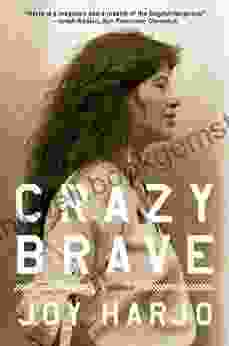
 Guillermo BlairCrazy Brave: A Memoir of Resilience, Courage, and the Power of Words by Joy...
Guillermo BlairCrazy Brave: A Memoir of Resilience, Courage, and the Power of Words by Joy... Russell MitchellFollow ·5.9k
Russell MitchellFollow ·5.9k VoltaireFollow ·19.5k
VoltaireFollow ·19.5k Art MitchellFollow ·10.6k
Art MitchellFollow ·10.6k Jack ButlerFollow ·13.3k
Jack ButlerFollow ·13.3k Evan HayesFollow ·14.7k
Evan HayesFollow ·14.7k Cristian CoxFollow ·6.1k
Cristian CoxFollow ·6.1k Richard WrightFollow ·5.9k
Richard WrightFollow ·5.9k Ted SimmonsFollow ·6.2k
Ted SimmonsFollow ·6.2k
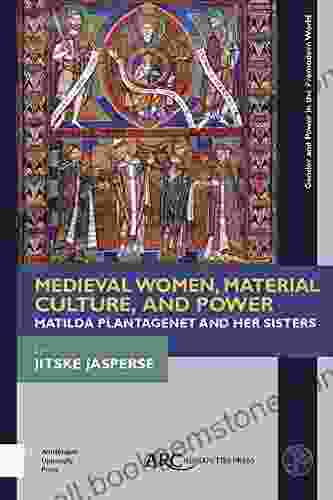
 Dennis Hayes
Dennis HayesMatilda Plantagenet and Her Sisters: Gender and Power in...
The lives of Matilda Plantagenet and her...
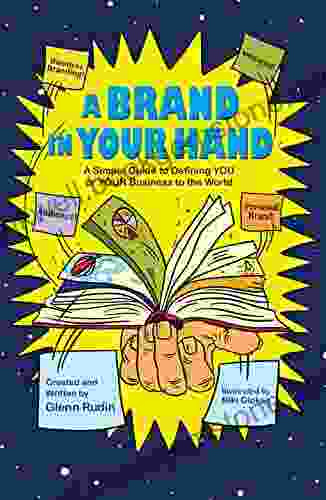
 Carl Walker
Carl WalkerA Comprehensive Guide to Defining Yourself or Your...
In today's competitive world, it's...

 Eliot Foster
Eliot FosterThe Civilization of the Renaissance in Italy: Classics,...
The Renaissance was a period of great cultural...
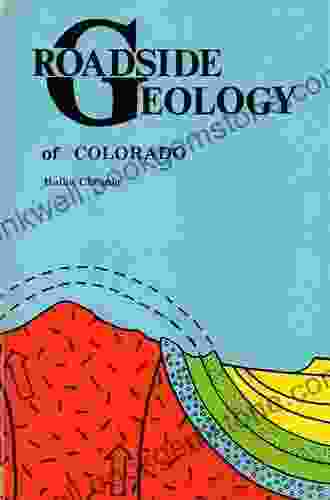
 Floyd Richardson
Floyd RichardsonUnveiling the Roadside Geology of Colorado: A Halka...
Colorado, a state renowned for its...
4.5 out of 5
| Language | : | English |
| File size | : | 2279 KB |
| Text-to-Speech | : | Enabled |
| Screen Reader | : | Supported |
| Enhanced typesetting | : | Enabled |
| Word Wise | : | Enabled |
| Print length | : | 418 pages |
| Lending | : | Enabled |


